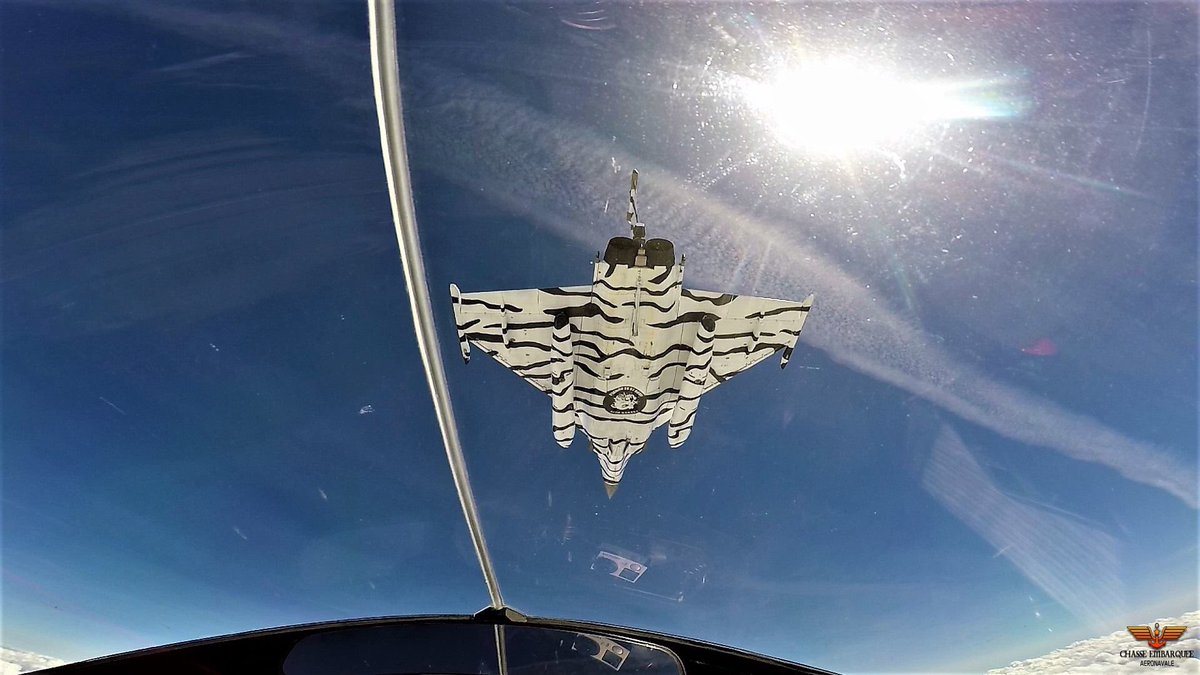You are using an out of date browser. It may not display this or other websites correctly.
You should upgrade or use an alternative browser.
You should upgrade or use an alternative browser.
France Military News, Reports, Data, etc.
- Thread starter navyreco
- Start date
Jura The idiot
General
now I watched
I'm guessing it shows elements of the 12th Tank Battalion
Landivisiau naval base: preparation of the Nato Tiger Meet 2017
For its 53rd edition, it is the Navy, through the 11F fleet of the naval aircraft base of Landivisiau, which organizes this important event from Monday 05 to Friday 16 June 2017. Twelve nations and more than fifty Aircraft and combat helicopters will be present.
Objectives: To exchange, transmit, strengthen and improve interoperability between different nations by training over 800 complex aeromagnetic and aeromaritime exercises to ensure the success of joint inter-allied and joint operations.


For its 53rd edition, it is the Navy, through the 11F fleet of the naval aircraft base of Landivisiau, which organizes this important event from Monday 05 to Friday 16 June 2017. Twelve nations and more than fifty Aircraft and combat helicopters will be present.
Objectives: To exchange, transmit, strengthen and improve interoperability between different nations by training over 800 complex aeromagnetic and aeromaritime exercises to ensure the success of joint inter-allied and joint operations.

Jura The idiot
General
google translation of
L'effort naval thalassocratique est-il soutenable ?
:
"The two naval efforts of China and the United States of America deserve to be summarily compared. From there, there is room to allow oneself to relativize a few perceptions of Chinese power or any attempt at sea-going. It is more interesting to note that over long time, China could inexorably exceed military power US.
Relationships and perceptions between US and Chinese military budgets are complex without being complicated. Although most of the analyzes now indicate that the military budget in Beijing is or has already exceeded $ 150 billion, the US budget for the next fiscal year should remain well above 600 billion.
On the other hand, assuming a GDP growth of about 3% per year in the United States of America against, approximately, 6.5% in China - virtually the key figure for military spending growth in China - Should see military spending in Beijing surpass Washington's by 2040. In addition, the defense budget in China would be only 1.7 or 1.8%, compared to more than twice the size in the United States, 4%.
The long time allows to assert, in this perspective, the Chinese pre-eminence on the military plane by linking it solidly to its economic development. And in this perspective, the creed of peaceful development can sound right.
In detail and concerning our favorite part, it will still take many years before the People's Liberation Army (MAPL) Navy can fully compete with the US Navy. Russia and China are the two main navies structuring opposition to the American thalassocracy and NATO forces. Their meeting (1.15 million tons for Russia, 1.2 million for China), even a one-off one, for example in joint exercises conducted from the Mediterranean to the Pacific Ocean, constitutes a kind of fleet in being (Fleet alive) to just over two-thirds of the US Navy (more than 3 million tons), or just under one-third of the US Navy plus its allies (about 4.7 million tons) .
After discussing this brief quantitative comparison by tonnage, and without dwelling on a qualitative comparison, let us return to the financial analysis. For the next fiscal year, the US Navy and USMC budgets are expected to reach nearly $ 180 billion ($ 172 billion in 2017). It should be noted immediately that in most analyzes, the entire Chinese military budget is somewhat lower than this amount.
The MAPL would receive a moderate portion of this budget, rather similar to the situation of the French navy, that is to say between 15 and 20%. In hard cash, it would be between $ 22.5 billion and $ 30 billion on a $ 150 billion budget. Even adjusting the Chinese military budget hypothesis by calling from other sources would not fundamentally alter its value relative to the US military budget, particularly its naval budget. The Chinese naval budget represents "only" one seventh or one fifth.
If this distribution of the naval budget was strictly the right one, then there would be room to put a Chinese seaplane into perspective with this very modest effort, as would the importance of the maritime component of the OBOR.
Still, with a more than 3 million tons for 180 billion compared to 1.2 million for 22.5 to 30 billion, China seems to have a higher budgetary efficiency. A host of parameters should be taken into account, as other expenditures are involved both in terms of maintenance, training of forces or actual days of vessels in operations, etc.
All this amounts to questioning the sustainability of the naval effort of the two nations. The procrastination of Donald J. Trump's naval plan to 350 combat ships shows that it will not be simple or even very difficult to achieve the self-assigned objective during the election campaign. On the Chinese side, naval expenditures sometimes show, rarely, certain limits which the perception of an overpowering China tends to erase. With a naval budget of a fairly small fraction of that of the United States of America, would Beijing be able to maintain four, five, six or even more carrier groups, ESRs?
In any case, there may be scope for exploring the financial translation and the long time of each other's naval aspirations when a British Pacific Fleet could be reconstituted, enjoying an almost exaggerated political voluntarism ."
L'effort naval thalassocratique est-il soutenable ?
:
"The two naval efforts of China and the United States of America deserve to be summarily compared. From there, there is room to allow oneself to relativize a few perceptions of Chinese power or any attempt at sea-going. It is more interesting to note that over long time, China could inexorably exceed military power US.
Relationships and perceptions between US and Chinese military budgets are complex without being complicated. Although most of the analyzes now indicate that the military budget in Beijing is or has already exceeded $ 150 billion, the US budget for the next fiscal year should remain well above 600 billion.
On the other hand, assuming a GDP growth of about 3% per year in the United States of America against, approximately, 6.5% in China - virtually the key figure for military spending growth in China - Should see military spending in Beijing surpass Washington's by 2040. In addition, the defense budget in China would be only 1.7 or 1.8%, compared to more than twice the size in the United States, 4%.
The long time allows to assert, in this perspective, the Chinese pre-eminence on the military plane by linking it solidly to its economic development. And in this perspective, the creed of peaceful development can sound right.
In detail and concerning our favorite part, it will still take many years before the People's Liberation Army (MAPL) Navy can fully compete with the US Navy. Russia and China are the two main navies structuring opposition to the American thalassocracy and NATO forces. Their meeting (1.15 million tons for Russia, 1.2 million for China), even a one-off one, for example in joint exercises conducted from the Mediterranean to the Pacific Ocean, constitutes a kind of fleet in being (Fleet alive) to just over two-thirds of the US Navy (more than 3 million tons), or just under one-third of the US Navy plus its allies (about 4.7 million tons) .
After discussing this brief quantitative comparison by tonnage, and without dwelling on a qualitative comparison, let us return to the financial analysis. For the next fiscal year, the US Navy and USMC budgets are expected to reach nearly $ 180 billion ($ 172 billion in 2017). It should be noted immediately that in most analyzes, the entire Chinese military budget is somewhat lower than this amount.
The MAPL would receive a moderate portion of this budget, rather similar to the situation of the French navy, that is to say between 15 and 20%. In hard cash, it would be between $ 22.5 billion and $ 30 billion on a $ 150 billion budget. Even adjusting the Chinese military budget hypothesis by calling from other sources would not fundamentally alter its value relative to the US military budget, particularly its naval budget. The Chinese naval budget represents "only" one seventh or one fifth.
If this distribution of the naval budget was strictly the right one, then there would be room to put a Chinese seaplane into perspective with this very modest effort, as would the importance of the maritime component of the OBOR.
Still, with a more than 3 million tons for 180 billion compared to 1.2 million for 22.5 to 30 billion, China seems to have a higher budgetary efficiency. A host of parameters should be taken into account, as other expenditures are involved both in terms of maintenance, training of forces or actual days of vessels in operations, etc.
All this amounts to questioning the sustainability of the naval effort of the two nations. The procrastination of Donald J. Trump's naval plan to 350 combat ships shows that it will not be simple or even very difficult to achieve the self-assigned objective during the election campaign. On the Chinese side, naval expenditures sometimes show, rarely, certain limits which the perception of an overpowering China tends to erase. With a naval budget of a fairly small fraction of that of the United States of America, would Beijing be able to maintain four, five, six or even more carrier groups, ESRs?
In any case, there may be scope for exploring the financial translation and the long time of each other's naval aspirations when a British Pacific Fleet could be reconstituted, enjoying an almost exaggerated political voluntarism ."
Jura The idiot
General
May 19, 2017
still don't know:did they 'hit' anything, or 'released' the weapon?
French Navy fires Aster 30 to train crew, vessel for airborne threats
Couteau Delta " Demo Team on Mirage 2000D have replaced recently " Ramex Delta " on Mirage 2000N retired next year replaced by new Rafale.
View attachment 38933










